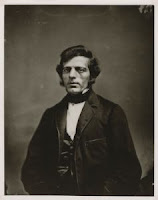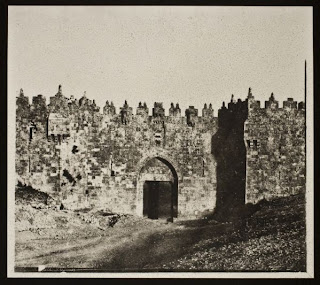Who Was the 19th Century American Preacher Mendenhall John Dennis?
Actually, He Was a Jerusalem Watchmaker Named Mendel Deniss, Jerusalem's First Photographer
 |
Mendenhall John Dennis in the center surrounded by his family in 1885. After 1860
he lived in Ohio, Massachusetts and Washington. Before 1860 he was Mendel Diness of Jerusalem (With permission of Special Collections, Fine Arts Library, Harvard University) |
A version of this article appeared in the Times of Israel on December 26, 2012
In 1988, John Barnier visited a garage sale in St. Paul, Minnesota. There he found and purchased eight boxes of old photographic glass plates. Fortunately, Barnier is an expert in the history of photographic printing.
He had little idea that he had uncovered a historic treasure. Later, he viewed the plates and saw that they included old pictures of Jerusalem. He contacted the Harvard Semitic Museum in Cambridge, Massachusetts, known for its large collection of old photographs from the Middle East.
On some of the plates they found the initials MJD. Until then the name Mendel Diness was barely known by scholars. It was assumed that with the exception of one or two photos his collection was lost.
In 1988, John Barnier visited a garage sale in St. Paul, Minnesota. There he found and purchased eight boxes of old photographic glass plates. Fortunately, Barnier is an expert in the history of photographic printing.
He had little idea that he had uncovered a historic treasure. Later, he viewed the plates and saw that they included old pictures of Jerusalem. He contacted the Harvard Semitic Museum in Cambridge, Massachusetts, known for its large collection of old photographs from the Middle East.
On some of the plates they found the initials MJD. Until then the name Mendel Diness was barely known by scholars. It was assumed that with the exception of one or two photos his collection was lost.
 |
| The Western Wall, photographed by Diness. Unlike most early photographers of the Wall, Diness pointed his camera to the south and not to the north. (With permission of Special Collections, Fine Arts Library, Harvard University. 1859) |
Thanks to the research of historians and curators Dror Wahrman, Nitza Rosovsky and Carney Gavin, the Diness collection was saved from obscurity, and an amazing tale was revealed: American Christian preacher Mendenhall John Dennis and Jerusalemite yeshiva student and watchmaker Mendel Diness were one and the same.
Diness was born in Odessa in 1827 into a religious Jewish family. As a boy he apprenticed as a watchmaker; as a teen he went to study in Heidelberg and was influenced by the anti-religious "enlightenment movement." His concerned father sent him to Palestine in 1848 to a yeshiva to strengthen his Jewish faith.
But in 1849 he met aChristian missionary who started him on his path to Christianity. His conversion caused a major controversy in the Old City of Jerusalem. Diness was excommunicated from the Jewish community, lost his business, and was forced to divorce his wife, Shayndel Reisa, who was from a hassidic Chabad family in Hebron.
Diness was born in Odessa in 1827 into a religious Jewish family. As a boy he apprenticed as a watchmaker; as a teen he went to study in Heidelberg and was influenced by the anti-religious "enlightenment movement." His concerned father sent him to Palestine in 1848 to a yeshiva to strengthen his Jewish faith.
But in 1849 he met a
| Mishkenot Sha'ananim in Jerusalem under Moshe Montifiore's windmill. The building project was the first Jewish neighborhood built outside of the Old City (1860, Special Collections, Fine Arts Library, Harvard University.) |
Diness was taken in by Christian missionaries and families, including the British Consul, James Finn, who baptized the new convert. His wife, Elizabeth Finn, a fan of the new photography art, was close to a Scottish missionary, James Graham, who taught Diness the new field of photography. It was not simply a question of learning to press a button on a camera, but it involved a lengthy and difficult process of preparing emulsions and plates (not film), mastering light, exposures and the science of developing the pictures.
Diness was taken in by Christian missionaries and families, including the British Consul, James Finn, who baptized the new convert. His wife, Elizabeth Finn, a fan of the new photography art, was close to a Scottish missionary, James Graham, who taught Diness the new field of photography. It was not simply a question of learning to press a button on a camera, but it involved a lengthy and difficult process of preparing emulsions and plates (not film), mastering light, exposures and the science of developing the pictures.
 |
| A portrait of missionary James Graham taken by Diness. It is not a portrait of Diness as claimed by some collections (1857) |
By 1856, Mendel Diness was photographing on his own. By the end of the decade, however, other photographers had flocked to Jerusalem, and Diness found the competition daunting. In 1861, he moved to the United States with his new wife, the daughter of a Jewish doctor who had converted to Christianity. Diness was unsuccessful as a photographer in Cincinnati, Ohio and became a peripatetic preacher, renamed as Mendenhall John Dennis.
How did the Dennis/Diness' collection end up in St. Paul? When he died in 1900 his belongings were apparently sent to his daughter in New Jersey. When her daughter died, a grandson cleaned out her attic and took the crates to Minnesota. The family was unaware of Dennis/Diness' Jerusalem photography background.
How did the Dennis/Diness' collection end up in St. Paul? When he died in 1900 his belongings were apparently sent to his daughter in New Jersey. When her daughter died, a grandson cleaned out her attic and took the crates to Minnesota. The family was unaware of Dennis/Diness' Jerusalem photography background.
 |
| The Damascus Gate photographed by Diness (Special Collections, Fine Arts Library, Harvard University, circa 1856) |
A footnote: Diness was not the only Jewish photographer in the Holy Land who converted to Christianity. Peter Bergheim, a German Jew who converted in the 1830s in England, arrived in Palestine in 1838. He worked as pharmacist and then opened a bank. In 1859 he became an accomplished photographer, apparently working for the British Ordnance Survey team. (His works appear frequently in these pages.)
A footnote: Diness was not the only Jewish photographer in the Holy Land who converted to Christianity. Peter Bergheim, a German Jew who converted in the 1830s in England, arrived in Palestine in 1838. He worked as pharmacist and then opened a bank. In 1859 he became an accomplished photographer, apparently working for the British Ordnance Survey team. (His works appear frequently in these pages.)
Several years later Elijah Meyers, a Bombay, India Jew who converted to Christianity, appeared on the scene. He was the founder and director of the American Colony Photo Department in 1898, but "he had been taking photographs before he became connected to the American Colony," according to a Colony publication. He trained a team in the art of photography and documented the visit of the German Kaiser in 1898 with pictures sold around the world. According to sources at the Library of Congress, Meyers was hired by Theodor Herzl to photograph Jewish settlements prior to the 1899 Zionist Congress in Basel.

